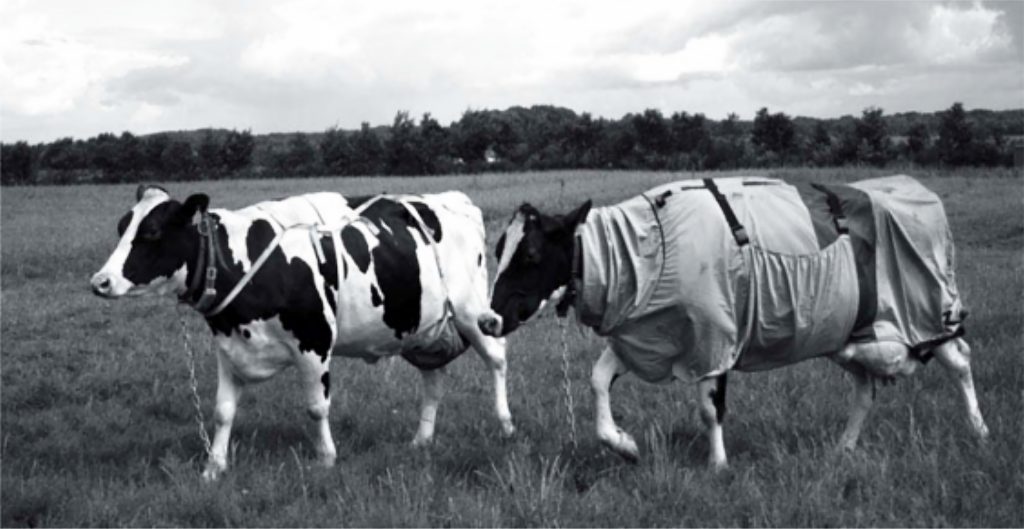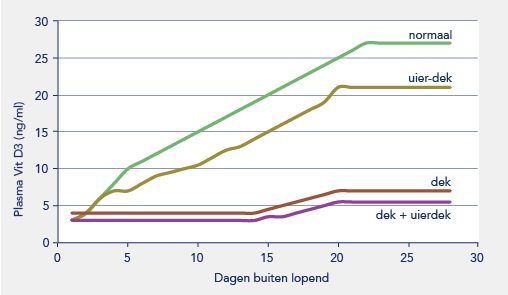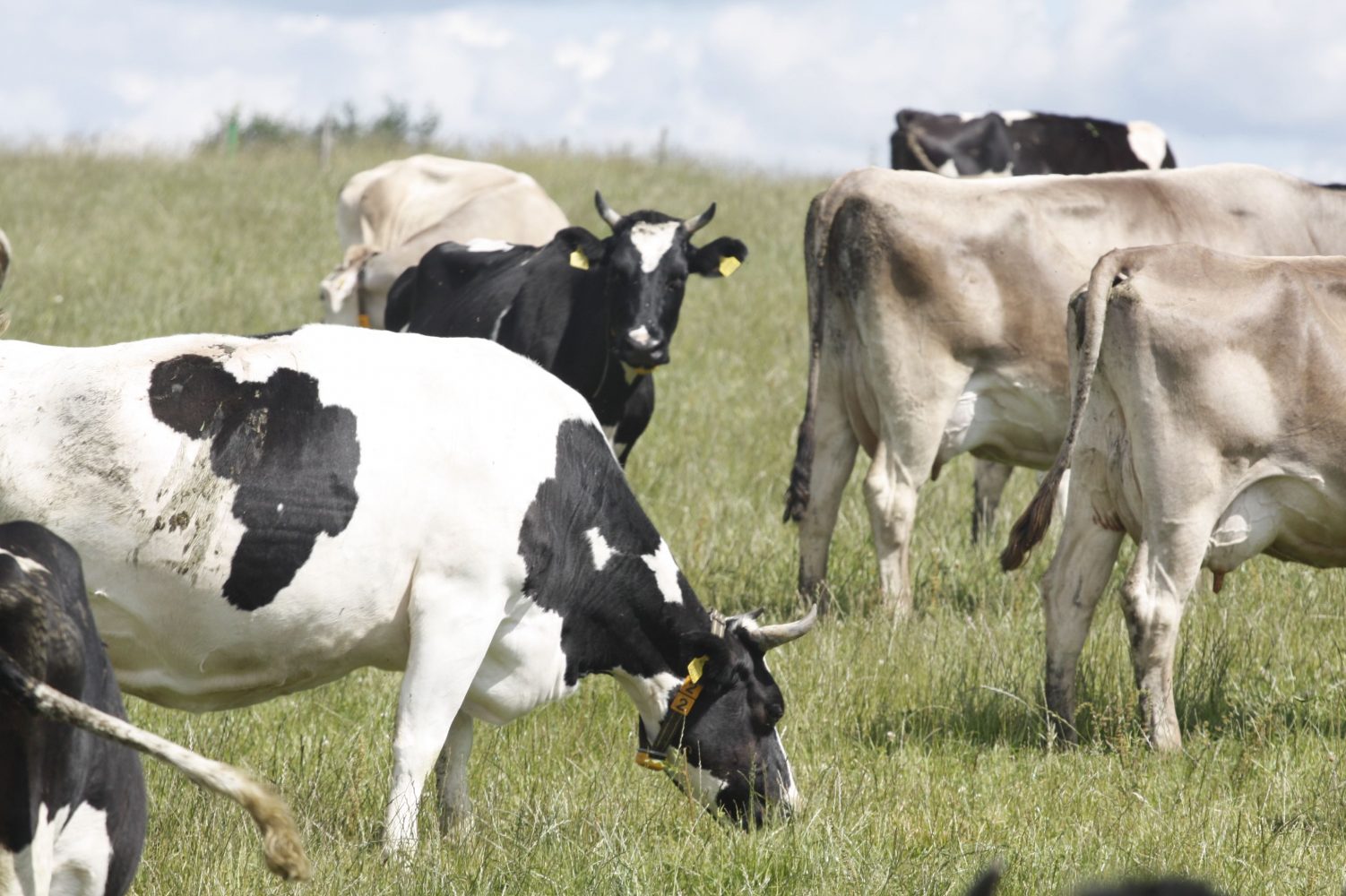Take home message
Milk markers of grass-based systems, grazing and grass intake in cows are CLAc9t11 concentration, a low ratio of n6/n3 (around 1), a high vitamin D3 and phytanic acid concentration in milk fat and a low ratio of SRR/RRR diasteromers as derivates from phytanic acid.
Vitamins and grazing
Important research was carried out by Danish researchers Hymoller et al. regarding the vitamin D content of milk (2010 and 2012). In a first study they evaluated which skin parts of the cow produce Vitamin D3 and what the relationship is between exposure time (hours per day), irradiated skin surface and Vitamin D3 in milk fat. Cows grazed outside under a horse blanket, which covered them completely, or a mini blanket that covered only the hairless udder. They wanted to understand, if the hairy skin was less accessible for sun radiation than the smooth udder skin. In a 2nd study, the cows were divided into groups, which were given either limited or long time access to pasture, completely uncovered. The aim was to determine the minimum exposure time and the maintenance of the D3 status in the blood.
The result of the 1st study was that cows produce D3 in their entire skin, also in the hairy skin. If you put the cows covered outside under a horse blanket, it is as if they are walking in the sun. In the 2nd study it was found that cows that are outside for less than 1½ hours /day, they will lose D3 in their blood, as measured over the period of 30 days. Only above 1½ hours daily access to pasture (measured at times around noon), the blood D3-values slowly increased. The experiments were indicative of the way in which cows produce D3 that can be released in their milk naturally from sunlight.

Photo of the Danish ‘test cows’: the left cow has only a covered udder, the right cow is covered with a horse blanket (from Hymoller et al., 2010)

Fig.1 The increase in the Vitamin-D3 content in milk from grass-based cows, depending on whether the animals are covered with non-translucent material: normal = uncovered cows; deck = horse deck; udder = covered udder
Vitamins in different systems
Kusche et al. (2013) studied the the concentration of three fat-soluble vitamins (antioxidants) in four dairy systems: biological low input (BLI), biological high input (BHI), conventional low input (CLI) and conventional high input (CHI). β-Carotene, Retinol and α-Tocopherol in cow’s milk were measured three times during the summer months. β-carotene or Provitamin A is a chemical precursor of Vitamin A1 or Retinol, α-Tocopherol is one of the forms of Vitamin E.
Table. Concentration of antioxidants (μg per liter), chlorophyl derivatives and some fatty acids (mg per gram of milk fat) in cow’s milk from four groups of dairy farms in the summer. BLI = biodynamic low-input; BHI = biodynamic high-input; CLI = conventional low-input; CHI = conventional high input. Both LI-groups only have grass intake; HI-groups feed additional silage from grass and maize. Concentrate levels are different between the groups, lowest in B-groups.
| BLI | BHI | CLI | CHI | |
| Fat-soluble vitamines: | ||||
| β-Caroteen (Provitamine A) | 159 a | 136 ab | 120 bc | 99 c |
| Retinol (Vitamine A1) | 343 | 374 | 394 | 388 |
| α-Tocoferol (Vitamine E) | 985 a | 832 ab | 695 b | 658 b |
| Chlorophyl derivates: | ||||
| Phytanic acid | 303 a | 351 a | 255 ab | 185 b |
| SRR/RRR ratio | 0.5 c | 1.3 b | 0.7 bc | 2.1 a |
| Fatty acids: | ||||
| CLAc9t11 | 13.0 a | 7.9 b | 12.0 a | 5.4 c |
| C18:3n-3 (ALA) | 10.9 a | 7.0 b | 7.0 b | 4.7 c |
| n-6/n-3 ratio | 1.3 c | 1.8 b | 1.7 b | 2.8 a |
(Different letter in the same row indicate significant differences)
The contrast between the two most different systems (BLI versus CHI) is striking. BLI represents extensive dairy farming, where the cows have access to pasture day and night, while the CHI represents modern conventional dairy farming, where the cows stay inside and fed conserved forages (maize silage, grass silage) plus concentrates. The other two systems are in between these two systems. Both β-Carotene and α-Tocopherol are higher in the organic systems. Retinol concentrations was not different between the systems. When these results are compared with the fatty acid composition, there seems to be a correlation with α-linolenic acid and the ratio between n6 n3, as well as a correlation between CLAc9t11 and vitamin D3. This last correlation is a logical outcome of grazing: grass is transformed in higher CLAc9t11 and grazing in the sun into higher Vitamin D3 in milk fat.
Phytanic acid
Chlorophyll gives the green color to plants. Chlorophyll enables the plants to convert carbon dioxide and water into glucose and oxygen with the help of sunlight. It forms the basis of the energy metabolism of the plants. Phytanic acid is a long-chain fatty acid (C-20). It has the special feature that it forms all kinds of side branches (branched chain). Phytanic acid is released during the digestion of chlorophyl and is therefore seen as another indicator for grazing and intake of fresh grass. During the degradation, other derivatives are released, which are used as markers, the so-called SRR and RRR diasteromers. The ratio between the two reflects the chlorophyl intake through the feed; the lower the ratio, the more higher the grass intake.
Literature
- Hymøller, L., & Jensen, S. K. (2010). Vitamin D3 synthesis in the entire skin surface of dairy cows despite hair coverage. Journal of dairy science, 93(5), 2025-2029.
- Hymøller, L., & Jensen, S. K. (2012). 25-Hydroxycholecalciferol status in plasma is linearly correlated to daily summer pasture time in cattle at 56 N. British journal of nutrition, 108(4), 666-671.
- Kusche, D., Kuhnt, K., Ruebesam, K., Rohrer, C., Nierop, A. F., Jahreis, G., & Baars, T. (2015). Fatty acid profiles and antioxidants of organic and conventional milk from low‐and high‐input systems during outdoor period. Journal of the Science of Food and Agriculture, 95(3), 529-539.
Photo: grazing dairy cows in a mixed herd of Holstein Frisian and Brown Swiss




